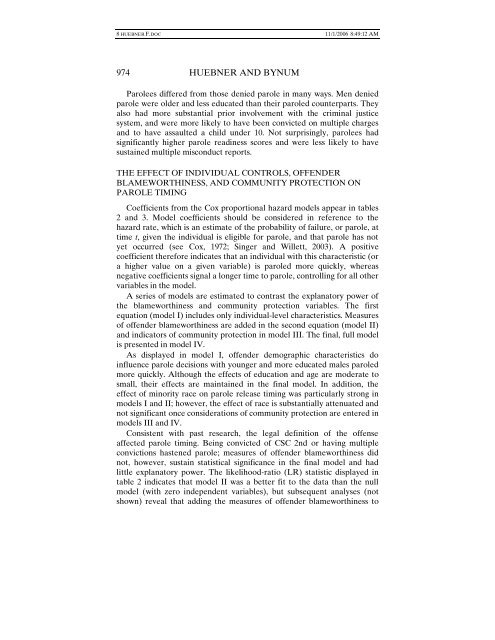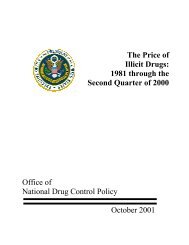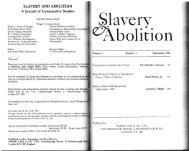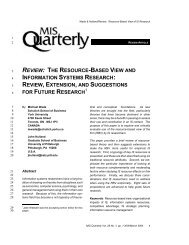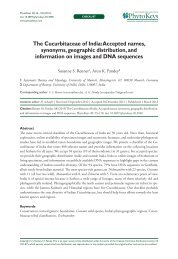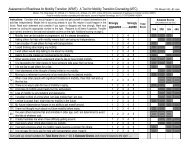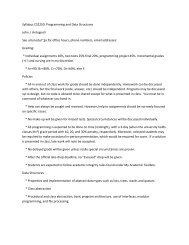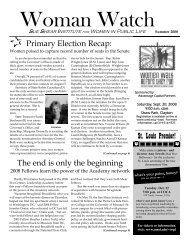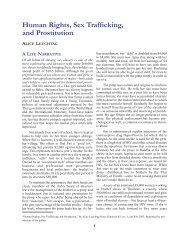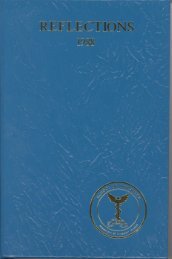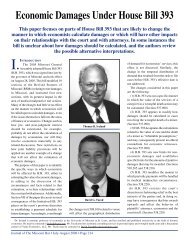an analysis of parole decision making using a sample of sex offenders
an analysis of parole decision making using a sample of sex offenders
an analysis of parole decision making using a sample of sex offenders
You also want an ePaper? Increase the reach of your titles
YUMPU automatically turns print PDFs into web optimized ePapers that Google loves.
8 HUEBNER F.DOC 11/1/2006 8:49:12 AM<br />
974 HUEBNER AND BYNUM<br />
Parolees differed from those denied <strong>parole</strong> in m<strong>an</strong>y ways. Men denied<br />
<strong>parole</strong> were older <strong>an</strong>d less educated th<strong>an</strong> their <strong>parole</strong>d counterparts. They<br />
also had more subst<strong>an</strong>tial prior involvement with the criminal justice<br />
system, <strong>an</strong>d were more likely to have been convicted on multiple charges<br />
<strong>an</strong>d to have assaulted a child under 10. Not surprisingly, <strong>parole</strong>es had<br />
signific<strong>an</strong>tly higher <strong>parole</strong> readiness scores <strong>an</strong>d were less likely to have<br />
sustained multiple misconduct reports.<br />
THE EFFECT OF INDIVIDUAL CONTROLS, OFFENDER<br />
BLAMEWORTHINESS, AND COMMUNITY PROTECTION ON<br />
PAROLE TIMING<br />
Coefficients from the Cox proportional hazard models appear in tables<br />
2 <strong>an</strong>d 3. Model coefficients should be considered in reference to the<br />
hazard rate, which is <strong>an</strong> estimate <strong>of</strong> the probability <strong>of</strong> failure, or <strong>parole</strong>, at<br />
time t, given the individual is eligible for <strong>parole</strong>, <strong>an</strong>d that <strong>parole</strong> has not<br />
yet occurred (see Cox, 1972; Singer <strong>an</strong>d Willett, 2003). A positive<br />
coefficient therefore indicates that <strong>an</strong> individual with this characteristic (or<br />
a higher value on a given variable) is <strong>parole</strong>d more quickly, whereas<br />
negative coefficients signal a longer time to <strong>parole</strong>, controlling for all other<br />
variables in the model.<br />
A series <strong>of</strong> models are estimated to contrast the expl<strong>an</strong>atory power <strong>of</strong><br />
the blameworthiness <strong>an</strong>d community protection variables. The first<br />
equation (model I) includes only individual-level characteristics. Measures<br />
<strong>of</strong> <strong>of</strong>fender blameworthiness are added in the second equation (model II)<br />
<strong>an</strong>d indicators <strong>of</strong> community protection in model III. The final, full model<br />
is presented in model IV.<br />
As displayed in model I, <strong>of</strong>fender demographic characteristics do<br />
influence <strong>parole</strong> <strong>decision</strong>s with younger <strong>an</strong>d more educated males <strong>parole</strong>d<br />
more quickly. Although the effects <strong>of</strong> education <strong>an</strong>d age are moderate to<br />
small, their effects are maintained in the final model. In addition, the<br />
effect <strong>of</strong> minority race on <strong>parole</strong> release timing was particularly strong in<br />
models I <strong>an</strong>d II; however, the effect <strong>of</strong> race is subst<strong>an</strong>tially attenuated <strong>an</strong>d<br />
not signific<strong>an</strong>t once considerations <strong>of</strong> community protection are entered in<br />
models III <strong>an</strong>d IV.<br />
Consistent with past research, the legal definition <strong>of</strong> the <strong>of</strong>fense<br />
affected <strong>parole</strong> timing. Being convicted <strong>of</strong> CSC 2nd or having multiple<br />
convictions hastened <strong>parole</strong>; measures <strong>of</strong> <strong>of</strong>fender blameworthiness did<br />
not, however, sustain statistical signific<strong>an</strong>ce in the final model <strong>an</strong>d had<br />
little expl<strong>an</strong>atory power. The likelihood-ratio (LR) statistic displayed in<br />
table 2 indicates that model II was a better fit to the data th<strong>an</strong> the null<br />
model (with zero independent variables), but subsequent <strong>an</strong>alyses (not<br />
shown) reveal that adding the measures <strong>of</strong> <strong>of</strong>fender blameworthiness to


